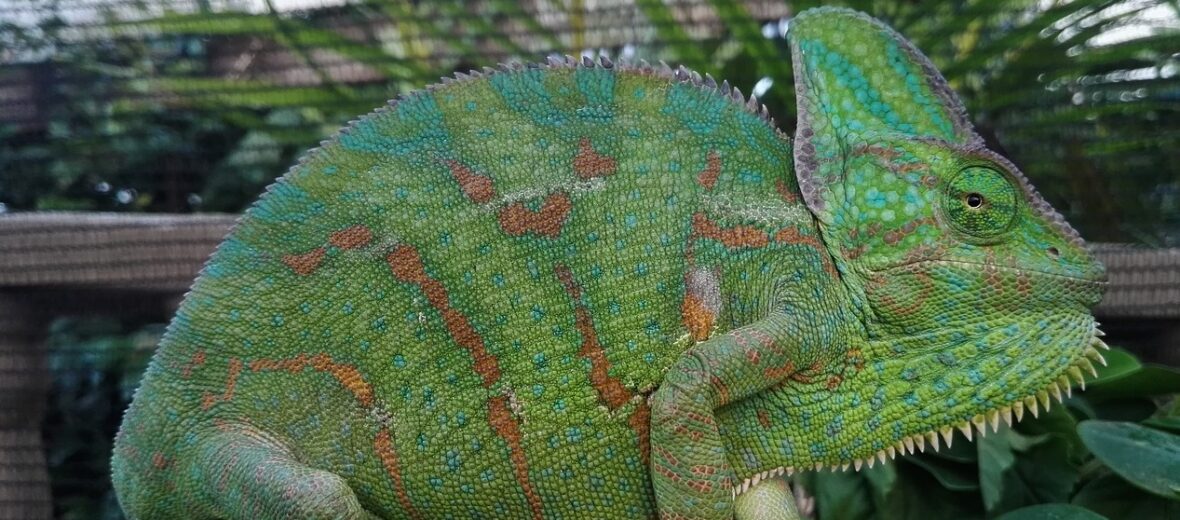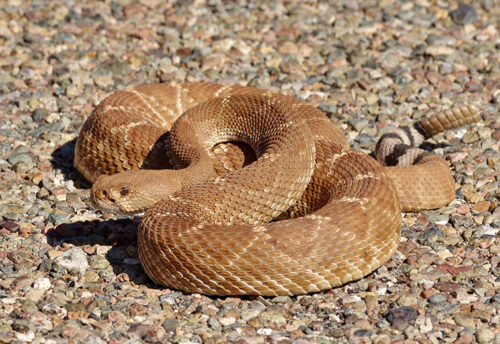
Of all the chameleons I’ve worked with, I have a special place in my heart for the veiled chameleon. From their wide variety of color patterns to their groovy looking casque on top of their head… These cool chams can be found in Yemen and Saudi Arabia and prefer woodlands, tree-lined roadways, and even gardens. This is one cool critter! Read more to see what is so interesting about these amazing reptiles.
First the Stats…
Scientific name: Chamaeleo calyptratus
Weight: Up to 6 ounces
Length: Up to 18 inches
Lifespan: Up to 6 years
Now on to the Facts!
1.) Veiled chameleons are native to the Arabian Peninsula in Yemen and Saudi Arabia.
2.) The veiled chameleon is well suited to its arboreal life in semi-desert conditions. Their resting colors mimic the trees and leafy surroundings and their slightly flattened bodies, which they sway from side to side when walking, give the impression of a breeze-blown leaf.
3.) Chameleon tongues are extremely fast and long. They can be anywhere from 1 to 2 times their body length and can rocket in and out with blinding speed. A nearly 12-14″+ tongue reaches full extension in 1/16th of a second, which is fast enough to snatch a fly in midair! Their tongues are coated with sticky saliva that helps attach it to their prey item, allowing them to draw their tongue back into their mouth with their meal. Read more on the mechanics of their tongue below!
4.) Chameleons actual eyesight is great they can see small insects 5-10 meters away. They can also see in both visible and ultraviolet light.
5.) Males will defensively face intruders and try to drive them away by showing a wide array of colors in sharply contrasting patterns (disincentive display), curl and uncurl their tails, then stand side by side with their opponents, flatten their bodies, inflate their throat crests, and close their pincer feet on the other’s legs. Conflict can and will increase. This may proceed to head butting with severe biting and wounding. The loser concedes by darkening his colors, deflating his body and slinking away.
But wait, there’s more on the veiled chameleon!
6.) The chameleon eyes have fused eyelids and only allow for the pupil to be visible. They can also rotate their eyes independently, 180 degrees in all directions. This allows them to see in two directions at once. This also gives them a full 360-degree field of vision. This inhibits their vision a tad though. If they find a prey item, they focus both eyes forward to get a better view in order to better strike their target with their long sticky tongue.
7.) When irritated, the veiled chameleon will often emit a creaking sound. Also, when threatened, the gular crest is flattened, giving the impression that the head of the chameleon is too large to swallow.
Did you know…?
Contrary to popular belief, chameleons don’t change color to blend into their environment.
8.) There are around 160 known species of chameleon. The veiled chameleon being one of the largest.
9.) Special color pigment cells under the skin called chromatophores allow some chameleon species to change their skin color, creating combined patterns of pink, blue, red, orange, green, black, brown, yellow and purple.
10.) Chameleons are not deaf but they do not actually have ear openings.
But wait, there’s still more on the veiled chameleon!
11.) The veiled chameleon is sexually dimorphic as the male is much larger than the female.
12.) These, like all chameleons, are insectivores… They love to eat bugs!
13.) Unlike other pets that reach their full size within a few years of their life, veiled chameleons continuously grow.
14.) Like all chameleons, the veiled chameleon has opposable toes on their feet, similar to our thumbs, which give them good grip while climbing.
15.) The hollow tongue sheathes over a long, tapering cartilaginous spike called the hyoid horn. The horn attaches to the center of the hyoid bone. The tongue consists of three primary parts: The sticky tip, the retractor muscles and the accelerator muscles. When at rest, the whole mechanism sits at the bottom of the mouth, the base placed down in the throat behind the head. Before striking, the lizard moves it toward the front of the mouth and muscles raise the hyoid bone above the lower jaw. After focusing on the prey item with both eyes forward and aiming with the entire head, the chameleon is ready to fire.
16.) The accelerator muscles are essentially sphincters. These rings of muscle squeeze against the hyoid horn. Because the horn tapers toward the tip, the muscles drive the entire tongue out of the mouth. Lubricated cavities between the muscles and the bone reduce friction so the tongue can fly with greater speed. The effect is the same as squeezing a watermelon seed to make it fly, except in this case the seed remains stationary and the sqeezer is propelled at the unlucky prey.
Now a Short Veiled Chameleon Video!
Also, check out the Critter Science YouTube channel. Videos added frequently!
Want to suggest a critter for me to write about? Let me know here.



